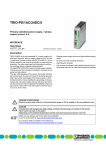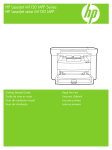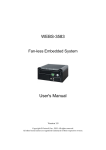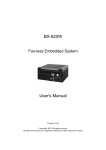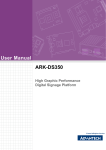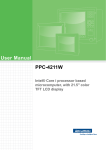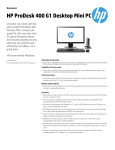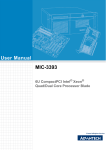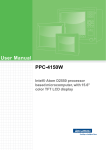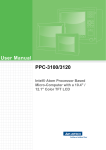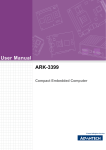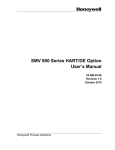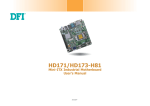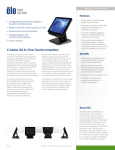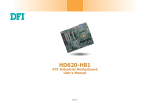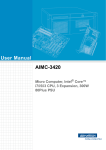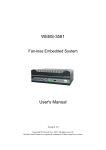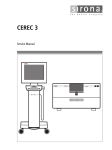Download User Manual PPC-6120
Transcript
User Manual PPC-6120 Intel® Core™ i / Celeron® based Panel PC with a 12.1" Color TFT LCD Copyright The documentation and the software included with this product are copyrighted 2014 by Advantech Co., Ltd. All rights are reserved. Advantech Co., Ltd. reserves the right to make improvements in the products described in this manual at any time without notice. No part of this manual may be reproduced, copied, translated or transmitted in any form or by any means without the prior written permission of Advantech Co., Ltd. Information provided in this manual is intended to be accurate and reliable. However, Advantech Co., Ltd. assumes no responsibility for its use, nor for any infringements of the rights of third parties, which may result from its use. Acknowledgements Intel and Pentium are trademarks of Intel Corporation. Microsoft Windows and MS-DOS are registered trademarks of Microsoft Corp. All other product names or trademarks are properties of their respective owners. Product Warranty (2 years) Advantech warrants to you, the original purchaser, that each of its products will be free from defects in materials and workmanship for two years from the date of purchase. This warranty does not apply to any products which have been repaired or altered by persons other than repair personnel authorized by Advantech, or which have been subject to misuse, abuse, accident or improper installation. Advantech assumes no liability under the terms of this warranty as a consequence of such events. Because of Advantech’s high quality-control standards and rigorous testing, most of our customers never need to use our repair service. If an Advantech product is defective, it will be repaired or replaced at no charge during the warranty period. For outof-warranty repairs, you will be billed according to the cost of replacement materials, service time and freight. Please consult your dealer for more details. If you think you have a defective product, follow these steps: 1. Collect all the information about the problem encountered. (For example, CPU speed, Advantech products used, other hardware and software used, etc.) Note anything abnormal and list any onscreen messages you get when the problem occurs. 2. Call your dealer and describe the problem. Please have your manual, product, and any helpful information readily available. 3. If your product is diagnosed as defective, obtain an RMA (return merchandize authorization) number from your dealer. This allows us to process your return more quickly. 4. Carefully pack the defective product, a fully-completed Repair and Replacement Order Card and a photocopy proof of purchase date (such as your sales receipt) in a shippable container. A product returned without proof of the purchase date is not eligible for warranty service. 5. Write the RMA number visibly on the outside of the package and ship it prepaid to your dealer. PPC-6120 User Manual Part No.200KC61220 Edition 1 Printed in China May 2014 ii Declaration of Conformity CE This product has passed the CE test for environmental specifications when shielded cables are used for external wiring. We recommend the use of shielded cables. This kind of cable is available from Advantech. Please contact your local supplier for ordering information. CE This product has passed the CE test for environmental specifications. Test conditions for passing included the equipment being operated within an industrial enclosure. In order to protect the product from being damaged by ESD (Electrostatic Discharge) and EMI leakage, we strongly recommend the use of CE-compliant industrial enclosure products. FCC Class A Note: This equipment has been tested and found to comply with the limits for a Class A digital device, pursuant to part 15 of the FCC Rules. These limits are designed to provide reasonable protection against harmful interference when the equipment is operated in a commercial environment. This equipment generates, uses, and can radiate radio frequency energy and, if not installed and used in accordance with the instruction manual, may cause harmful interference to radio communications. Operation of this equipment in a residential area is likely to cause harmful interference in which case the user will be required to correct the interference at his own expense. Technical Support and Assistance 1. 2. Visit the Advantech web site at www.advantech.com/support where you can find the latest information about the product. Contact your distributor, sales representative, or Advantech's customer service center for technical support if you need additional assistance. Please have the following information ready before you call: – Product name and serial number – Description of your peripheral attachments – Description of your software (operating system, version, application software, etc.) – A complete description of the problem – The exact wording of any error messages iii PPC-6120 User Manual Safety Instructions 1. 2. 3. Read these safety instructions carefully. Keep this User Manual for later reference. Disconnect this equipment from any AC outlet before cleaning. Use a damp cloth. Do not use liquid or spray detergents for cleaning. 4. For plug-in equipment, the power outlet socket must be located near the equipment and must be easily accessible. 5. Keep this equipment away from humidity. 6. Put this equipment on a reliable surface during installation. Dropping it or letting it fall may cause damage. 7. The openings on the enclosure are for air convection. Protect the equipment from overheating. DO NOT COVER THE OPENINGS. 8. Make sure the voltage of the power source is correct before connecting the equipment to the power outlet. 9. Position the power cord so that people cannot step on it. Do not place anything over the power cord. 10. All cautions and warnings on the equipment should be noted. 11. If the equipment is not used for a long time, disconnect it from the power source to avoid damage by transient overvoltage. 12. Never pour any liquid into an opening. This may cause fire or electrical shock. 13. Never open the equipment. For safety reasons, the equipment should be opened only by qualified service personnel. If one of the following situations arises, get the equipment checked by service personnel: The power cord or plug is damaged. Liquid has penetrated into the equipment. The equipment has been exposed to moisture. The equipment does not work well, or you cannot get it to work according to the user's manual. The equipment has been dropped and damaged. The equipment has obvious signs of breakage. 14. DO NOT LEAVE THIS EQUIPMENT IN AN ENVIRONMENT WHERE THE STORAGE TEMPERATURE MAY GO BELOW -20° C (-4° F) OR ABOVE 60° C (140° F). THIS COULD DAMAGE THE EQUIPMENT. THE EQUIPMENT SHOULD BE IN A CONTROLLED ENVIRONMENT. 15. CAUTION: DANGER OF EXPLOSION IF BATTERY IS INCORRECTLY REPLACED. REPLACE ONLY WITH THE SAME OR EQUIVALENT TYPE RECOMMENDED BY THE MANUFACTURER, DISCARD USED BATTERIES ACCORDING TO THE MANUFACTURER'S INSTRUCTIONS. 16. The sound pressure level at the operator's position according to IEC 704-1:1982 is no more than 70 dB (A). DISCLAIMER: This set of instructions is given according to IEC 704-1. Advantech disclaims all responsibility for the accuracy of any statements contained herein. PPC-6120 User Manual iv Safety Precaution - Static Electricity Follow these simple precautions to protect yourself from harm and the products from damage. To avoid electrical shock, always disconnect the power from your PC chassis before you work on it. Don't touch any components on the CPU card or other cards while the PC is on. Disconnect power before making any configuration changes. The sudden rush of power as you connect a jumper or install a card may damage sensitive electronic components. Battery Information Batteries, battery packs and accumulators should not be disposed of as unsorted household waste. Please use the public collection system to return, recycle, or treat them in compliance with the local regulations. v PPC-6120 User Manual PPC-6120 User Manual vi Contents Chapter 1 Overview...............................................1 1.1 1.2 Introduction ............................................................................................... 2 Specifications ............................................................................................ 2 1.2.1 General Specifications .................................................................. 2 1.2.2 Power Specifications..................................................................... 3 1.2.3 Touchscreen Specifications .......................................................... 3 1.2.4 Environment Specifications........................................................... 3 1.2.5 Certification ................................................................................... 4 1.2.6 IP Grade........................................................................................ 4 Dimensions ............................................................................................... 5 Figure 1.1 Dimensions................................................................. 5 1.3 Chapter 2 System Setup .......................................7 2.1 A Quick Tour ............................................................................................. 8 Figure 2.1 Front Panel of Panel PC............................................. 8 Figure 2.2 Side View of Panel PC ............................................... 9 Figure 2.3 IO Connectors of Panel PC ...................................... 10 Installation Procedures............................................................................ 11 2.2.1 Connecting Power Cord.............................................................. 11 Figure 2.4 Connecting Power Cord ........................................... 11 2.2.2 Connecting Keyboard and Mouse............................................... 11 2.2.3 Switching on Power .................................................................... 11 Installing CPU ......................................................................................... 12 Figure 2.5 Unfastening Screws on Rear Cover ......................... 12 Figure 2.6 Unplugging Switch Wire ........................................... 12 Figure 2.7 Remove rear cover ................................................... 13 Figure 2.8 CPU fasten in socket ................................................ 13 Figure 2.9 CPU cooler ............................................................... 14 Figure 2.10Assemble cooler ....................................................... 14 Installing Memory .................................................................................... 15 Figure 2.11Install Memory .......................................................... 15 Installing HDD ......................................................................................... 15 Figure 2.12Loosen HDD bracket screws .................................... 15 Figure 2.13Fix HDD in HDD brackets......................................... 16 Figure 2.14Assemble HDD ......................................................... 16 Installing mSATA..................................................................................... 17 Figure 2.15Assemble MSATA .................................................... 17 Installing Wireless LAN Card .................................................................. 17 Figure 2.16 Assemble wireless card and antenna...................... 17 Figure 2.17Replace the HDD module......................................... 18 Figure 2.18View of assemble antenna ....................................... 18 Installing PPC-6120-EXPE...................................................................... 19 Figure 2.19PPC-6120-EXPE module ......................................... 19 Figure 2.20Remove riser card door ............................................ 19 Figure 2.21Assemble riser card.................................................. 20 Figure 2.22Complete assemble expansion kits .......................... 20 Installing Hook......................................................................................... 21 Figure 2.23Installing Hook .......................................................... 21 Quick Installation of PPC ........................................................................ 22 Figure 2.24Put Panel PC into Cabinet........................................ 22 Figure 2.25Installing PC with Clamp........................................... 22 Figure 2.26Installing Hook .......................................................... 23 2.2 2.3 2.4 2.5 2.6 2.7 2.8 2.9 2.10 vii PPC-6120 User Manual Chapter 3 Jumpers and Connectors................. 25 3.1 Jumpers and Connectors........................................................................ 26 Figure 3.1 Front View of PCM-8210 .......................................... 26 Table 3.1: Connectors ............................................................... 26 External COM Ports Pin Definition.......................................................... 28 Figure 3.2 COM Port ................................................................. 28 3.2 Chapter 4 Software Setup.................................. 31 4.1 4.2 Driver Installation .................................................................................... 32 BIOS Setup Program .............................................................................. 32 4.2.1 Entering BIOS Setup .................................................................. 32 4.2.2 Adjustment of LCD Brightness.................................................... 33 4.2.3 COM5 Mode Selection (RS422/RS485) ..................................... 35 4.2.4 COM5 RS485 Terminate Selection ............................................ 36 4.2.5 Wake on LAN.............................................................................. 37 4.2.6 AT & ATX Setting........................................................................ 39 PPC-6120 User Manual viii Chapter 1 1 Overview This chapter gives basic information about the PPC-6120. Sections include: Introduction Specifications Dimensions 1.1 Introduction Advantech’s PPC-6120 is a 4th Generation Intel Core™ i / Celeron based Panel PC with a 12" color TFT LCD. It features extremely high computing power, various connectors, and can be installed in virtually any application. In addition, its user-friendly interface makes it a great host for information appliances. Four RS232, one isolated RS422/485 and Dual Gb Ethernet connectors support Intel AMT, one expansion slot make PPC-6120 highly reliable, and provides a great solution for versatile applications. 1.2 Specifications 1.2.1 General Specifications Product PPC-6120 LCD Specfication 12.1”LCD Display type 12.1”TFT LCD (LED backlight) Max. Resolution 1024 x 768 Supported Color 262K/16.2M Dot Pitch 0.240(H) x 0.240(V) View Angle 80 (left), 80 (right), 70 (up), 70 (down) Luminance 600 Contrast Ratio 700 Backlight Life 50,000 hrs Weight 3.8kg (8.38lb) Dimension 325.00 x 253.80 x 73.80 mm (12.80” x 9.99” x 2.91”) 4th Generation Intel® Core™ i / Celeron® Processor (Thermal Design Power: 35W/45W) CPU Type I7-4770TE I5-4570TE I3-4330TE PENTIUM-G3320TE Celeron-1820TE I5-4590T I3-4350T I3-4340TE Frequence 2.3GHz 2.7GHz 2.4GHz 2.3GHz 2.2GHz 2.0GHz 3.1GHz 2.6GHz Cache 8M 4M 4M 3M 2M 6M 4M 4M TDP 45W 35W 35W 35W 35W 35W 35W 35W Chipset Intel Q87 Memory Support dual channel DDR3/DDR3L up to 16 GB Storage 1 x standard SATA connector for HDD, 1 x mSATA socket Network (LAN) 2 x Gigabit Ethernet ports, support Intel AMT9.0 I/O 5 x COM port: 1 x RS422/485(isolation), 4 x RS232 4 x external USB 3.0 ports 1 x Display Port 1.2 1 x DB15 VGA out 1 x Line out port; 1 x MIC in 1 x Power Button Speaker 1W Stereo Speaker x 2 Bus Expansion OS Support PPC-6120 User Manual 1 x MiniPCIe (Standard) 1 x PCIe x 4 / 1 x PCI through riser (Optional) Win 7, Win 8, Win 8.1, Linux 2 Input Voltage 12 - 30 Vdc, 9.5A Note! For details about the above test conditions for power consumption, please see Remark 1. 1.2.3 Touchscreen Specifications Type Five wire resistive Resolution 2048 x 2048 Light Transmission 80%+/-3% Controller COM interface Durability 36 million 1.2.4 Environment Specifications Operating Temperature 0 ~ 50°C (32 ~ 122°F) Storage Temperature -20 ~ 60°C (-4 ~ 140°F) Relative Humidity 10 ~ 95% @ 40°C (Non-condensing) Shock 10 G peak acceleration (11 ms duration) Vibration 5 ~ 500 Hz 1 G RMS 3 PPC-6120 User Manual Overview Power Consumption I7-4770TE: 84W (Test system: Windows7 64bit), 83W (Test system: Windows8 64bit) I5-4590TE: 65W (Test system: Windows7 64bit), 61W (Test system: Windows8 64bit) I3-4330TE: 56W (Test system: Windows7 64bit), 54W (Test system: Windows8 64bit) Petium-G3320TE: 47W (Test system: Windows7 64bit), 46W (Test system: Windows8 64bit) Chapter 1 1.2.2 Power Specifications 1.2.5 Certification EMC BSMI, CE, FCC Class A Safety CB, CCC, BSMI, UL 1.2.6 IP Grade Front Panel Dust-Proof & Water-Proof IP65 compliant Remark 1: Power consumption (PPC-6120): Test Test Configuration Test System Burn-in 7.0 Memory: Transcend 8G DDR3 1600 * 1 HDD: Seageat 500G 2.5”* 1 IO: COM Port RS232 loopback x4, USB3.0 device *4 Win 7 (64bit) Win 8 (64bit) PPC-6120 User Manual 4 Chapter 1 1.3 Dimensions Overview Figure 1.1 Dimensions 5 PPC-6120 User Manual Note! Specification of mounting VESA screw: M4. Depth of screw hole: 6 mm (Max.). Warning! Use suitable mounting apparatus to avoid risk of injury. PPC-6120 User Manual 6 Chapter 2 2 System Setup Sections include: A Quick Tour Installation Procedures Installing Memory Installing HDD Installing Mini SATA Installing Wireless LAN Installing Expansion Card Installing Hook Quick Installation of PPC-6120 2.1 A Quick Tour Before starting to set up the panel PC, take a moment to become familiar with the locations and purposes of controls, drivers, connectors and ports, which are illustrated in the figures below. When placed upright on the desktop, the front panel of the panel PC appears as shown in Figure 2.1. Figure 2.1 Front Panel of Panel PC 1. 2. 3. 4. Light sense indicator (Light sense) Network status indicator (LAN LED) HDD status indicator (HDD LED) Power status indicator (Power LED) Status Power On (S0) PPC-6120 User Manual LAN LED LAN1 LAN2 Green (Operating, flashing) Yellow (Operating, flashing) 8 HDD LED POWER LED Yellow (Operating, flashing) Green Chapter 2 System Setup Figure 2.2 Side View of Panel PC 1. 2. 3. 4. Antenna hole CPU cooler holes Hook hole for panel mount (8 holes) Speaker (left & right) 9 PPC-6120 User Manual I/O connectors: Figure 2.3 IO Connectors of Panel PC A: MIC In B: Line Out C: USB 3.0 * 4 D: Gigabit Ethernet x 2 (supports iAMT 9.0) E: VGA Port F: Display Port 1.2 G: COM RS-232 x 4 H: DC inlet and AT/ATX switch I: RS422/485 (Isolation) PPC-6120 User Manual 10 2.2.1 Connecting Power Cord The panel PC can only be powered through a DC electrical outlet (12 ~ 30 V). Be sure to hold the plug end only. Follow these procedures to connect the power cord: 1. Connect the female end of the power cord to the DC inlet of the panel PC. 2. Connect the 3-pin male plug of the power cord to an electrical outlet. Chapter 2 2.2 Installation Procedures System Setup Figure 2.4 Connecting Power Cord 2.2.2 Connecting Keyboard and Mouse Connect the mouse and keyboard to the I/O connector of the panel PC. 2.2.3 Switching on Power The power switch is located on the lower right corner on the rear cover of the panel PC. 11 PPC-6120 User Manual 2.3 Installing CPU 1. Unfasten the screws on the rear cover (8 screws). Figure 2.5 Unfastening Screws on Rear Cover 2. Unplug the switch wire from the main board and remove the rear cover. Figure 2.6 Unplugging Switch Wire PPC-6120 User Manual 12 Remove rear cover. Chapter 2 3. System Setup Figure 2.7 Remove rear cover 4. Put the CPU in the CPU socket and fasten the securing bracket. Figure 2.8 CPU fasten in socket 13 PPC-6120 User Manual 5. Take the cooler from the carton, note that thermal pad is assembled on the cooler. Figure 2.9 CPU cooler 6. Place the cooler on the M/B frame and insert the cooler power cable. Figure 2.10 Assemble cooler PPC-6120 User Manual 14 1. Follow section 2.3 to remove rear cover, assemble memory in the location below, and place in the lowest socket first. Chapter 2 2.4 Installing Memory System Setup Figure 2.11 Install Memory 2.5 Installing HDD 1. 2. Follow section 2.3 step to remove rear cover. Remove the green tape and unfasten the four screws to take off HDD bracket. Figure 2.12 Loosen HDD bracket screws 15 PPC-6120 User Manual 3. Take four M3x5 screws out of the accessory box. Use the screws to secure the HDD into the bracket. Figure 2.13 Fix HDD in HDD brackets 4. Replace the HDD bracket and plug in the power cable. Figure 2.14 Assemble HDD 5. Attach the power cable to the main board. Replace the rear cover and secure it to finish the installation. PPC-6120 User Manual 16 1. 2. Follow the above procedure to remove the HDD bracket. Insert the mSATA into the slot on the main board and use 2 M2.5x4 screws from the accessory box to fix it. Chapter 2 2.6 Installing mSATA System Setup Figure 2.15 Assemble MSATA 3. Then replace the rear cover. 2.7 Installing Wireless LAN Card 1. 2. Follow the above procedures to take off the HDD bracket. The long wireless LAN card can be directly installed to the position shown in the below figure, while the short one needs the support of a hex bolt (in accessory box) to be fixed into the position. Fix the antenna into the position as shown below (left & right). Figure 2.16 Assemble wireless card and antenna 17 PPC-6120 User Manual 3. Replace the HDD bracket. Figure 2.17 Replace the HDD module 4. Connect the antenna to the wireless LAN card and attach the external antenna terminals. Then replace the rear cover to finish the installation. Figure 2.18 View of assemble antenna PPC-6120 User Manual 18 1. Take PPC-6120-EXPE module out of the box. Make sure you have correct riser card to be used. Take the PIC riser card as an example. Chapter 2 2.8 Installing PPC-6120-EXPE System Setup Figure 2.19 PPC-6120-EXPE module 2. Remove the screw that fixes the metal cover onto the back of PPC-6120, and then remove the cover. Figure 2.20 Remove riser card door 19 PPC-6120 User Manual 3. Secure the PPC-6120-EXPE onto the rear cover with screws (4 screws). Insert the golden fingers of the riser card into the slot and use the screws to fix it (2 screws). Figure 2.21 Assemble riser card 4. 5. Insert the desired card into the slot and use the screw to fix it. Replace the rear cover of PPC-6120-EXPE and use the screws (7 screws) to fix it. Figure 2.22 Complete assemble expansion kits Note! The size of PCI and PCIE card can not exceed 248mm long and 115mm wide. The total current load provided by the expansion slot is as follows: 12 V 2A 5V 2A 3.3 V 3A -12 V 100 mA Total output power of 12 V, 5 V and 3.3 V can not exceed 25 W. PPC-6120 User Manual 20 Chapter 2 2.9 Installing Hook Refer to the figure below to install the hook: How to Install Hook Plastic Tap Hook After the panel PC is installed in the cabinet, prepare the hook. Place the hook in the hole as the picture shows to hookup the panel PC. Screw Fasten the screw to fix the panel PC. Figure 2.23 Installing Hook 21 PPC-6120 User Manual System Setup Use tweezers to disassemble the plastic taps on four sides of the panel PC. 2.10 Quick Installation of PPC 1. Put the panel PC into the rack hole at an angle and attach it to the inside of the cabinet wall as shown in the figure below. Figure 2.24 Put Panel PC into Cabinet 2. Use one hand to support the PC, while using the other to push the PC into the cabinet by pushing up the clamp with a screwdriver. Figure 2.25 Installing PC with Clamp PPC-6120 User Manual 22 Once the panel PC is attached into the cabinet, use the hook to secure it. System Setup Figure 2.26 Installing Hook 4. If you want to remove the panel PC, reverse the above steps. 23 Chapter 2 3. PPC-6120 User Manual PPC-6120 User Manual 24 Chapter 3 3 Jumpers and Connectors Sections include: Jumpers and Connectors External COM Ports Pin Definition 3.1 Jumpers and Connectors Figure 3.1 Front View of PCM-8210 Table 3.1: Connectors Connectors Functions CN1 LCD Driver Board CN3 Internal USB 2.0 CN4 Panel ID control CN5 LVDS CN6 Internal USB 2.0 CN8 GPIO CN11 Touch JP1 RTC Select JP2 Touch Disable Select CN18 Light sense CN24 LED Board CN27 Speaker CN15 SATA Power CN14 COM Pin9 Power Select (COM1&COM2) CN25/CN26 Power Button SW2 AT/ATX Select SW1 DDR3 or DDR3L Select PPC-6120 User Manual 26 Graphic RTC Select (1-2) P1 Normal* (2-3) P2 CMOS Clear Default* JP2 P2 Graphic Touch Function (1-2) P3 Touch Enable (2-3) P4 Touch Disable Default* P3 P4 CN4 Graphic Panel Resolution (1-2)(5-6)(7-8) P5 1024*768 24bit (1-2)(7-8) P6 1280*1024 24bit (1-2)(3-4)(5-6) P7 1366*768 18bit (1-2) P8 1920*1080 24bit P5 P6 Default* P7 P8 CN14 Graphic COM1/2 RI Type Select (1-3)/(2-4) P9 COM1/COM2 RI (3-5)/(5-7) P10 COM1/COM2 5V (4-6)/(6-8) P11 COM1/COM2 5V (7-9)/(8-10) P12 COM1/COM2 12V P9 Default* P10 P11 P12 27 PPC-6120 User Manual Jumpers and Connectors P1 Chapter 3 JP1 SW1 Function OFF For DDR3 1.5V ON For DDR3L 1.35V Default* P13 SW2 AT/ATX Select 1-3 P14 ATX Power 2-3 P15 AT Power P14 Default* P15 3.2 External COM Ports Pin Definition Figure 3.2 COM Port PPC-6120 User Manual 28 COM1-2: Pin9 is set as RI signal in COM port by default, and could be set as 5V/12V output by Jumper COM4 doesn't support RING function. Pin COM1/COM2 COM3/COM4 1 DCD DCD 2 RXD RXD 3 TXD TXD 4 DTR DTR 5 GND GND 6 DSR DSR 7 RTS RTS 8 CTS CTS 9 RING or 5V/12V output RING(Only COM3) Pin9 is set as RI signal in COM port by default, and could be set as 5V/12V output by Jumper 29 PPC-6120 User Manual Jumpers and Connectors Note! Chapter 3 COM 1 and COM 2 (RS232, pin9 supports 5 V/12 V output) COM 3 and COM 4 (RS232) COM 5 RS422/485 COM5: RS422/485 with Isolation 1000 VDC, BIOS selectable Pin 1 2 3 4 5 RS422 TX+ TX- RX+ RX- GND RS485 D+ D- GND UART RS485 Auto Flow Control COM5 supports RS485 auto flow control function for all UART. When enabling the RS485 auto control function, it will automatically drive RTS# pin to logic high or low for flow control. To make this RS485 auto flow control function work, please be noted that the parity and stop-bit setting has to be one of the following three settings: (1) 8 data bits + 1 parity bit + 1stop bit (2) 8 data bits + 1 parity bit + 2 stop bits (3) 8 data bits + 2 stop bits PPC-6120 User Manual 30 Chapter 4 Software Setup Sections include: Driver Installation BIOS Setup Program 4 4.1 Driver Installation When you install the OS to panel PC for the first time, you should install the corresponding drivers to make sure all the functions will work properly. Take CD-ROM out of the accessory box and insert it into the system. Please complete the installation based on the operating system you use. The drivers on the CD-ROM may not be the latest version, please get the latest ones from the below websites: http://www.advantech.com 4.2 BIOS Setup Program 4.2.1 Entering BIOS Setup When the power is turned on, press the <Del> key to enter BIOS setup screen. Whenever a change is made, press <F4> to save and exit; otherwise the settings will not be saved in the BIOS. PPC-6120 User Manual 32 1. Chapter 4 4.2.2 Adjustment of LCD Brightness Select “Brightness Control” in “Chipset” tab. Software Setup A. Manual Mode “LCD Brightness Control” is set to “Manual Mode” by default, which means you should adjust the brightness by yourself. Select “Brightness Manual Control” under “Brightness Control”. There are in all six brightness levels to choose. 33 PPC-6120 User Manual B. Dynamic Mode “LCD Brightness Control” is set to “Dynamic Mode”, which means LCD will automatically sense the light and adjust the brightness accordingly. PPC-6120 User Manual 34 Chapter 4 4.2.3 COM5 Mode Selection (RS422/RS485) Select “Super IO Configuration” in “Advanced” tab. 2. Select “Serial Port 5 Configuration”. You can select the mode of COM5 through “Serial Port5 Mode”. Software Setup 1. 35 PPC-6120 User Manual 4.2.4 COM5 RS485 Terminate Selection 1. Select “Super IO Configuration” in “Advanced” tab. 2. Select Serial Port 5 Configuration and select Serial Port5 RS485 Terminate. PPC-6120 User Manual 36 Chapter 4 4.2.5 Wake on LAN A. Open wake on LAN function in windows 7. 1. Select “ACPI Settings” in “Advanced” tab. Software Setup 2. Set “Wake on by PCIE Wake#” and “Wake on LAN” to “Enabled”. 37 PPC-6120 User Manual 3. 4. Save the settings and exit OS. Right-click “Computer” to select “Manage” to open “Computer Management” window. 5. Click “Device Manager” and select “Network adapters”. Right-click the desired LAN port and select “Properties” to open “Realtek PCIe GBE Family Controller Properties” window. PPC-6120 User Manual 38 Select “Power Management” tab in “Realtek PCIe GBE Family Controller Properties" window, then check “Allow this device to wake the computer”. Chapter 4 6. Software Setup 4.2.6 AT & ATX Setting 1. Select "Chipset", then select "PCH-IO Configuration" 39 PPC-6120 User Manual 2. Select below “Restore AC Power Loss”. PPC-6120 User Manual 40 Chapter 4 Software Setup PPC-6120 User Manual 41 www.advantech.com Please verify specifications before quoting. This guide is intended for reference purposes only. All product specifications are subject to change without notice. No part of this publication may be reproduced in any form or by any means, electronic, photocopying, recording or otherwise, without prior written permission of the publisher. All brand and product names are trademarks or registered trademarks of their respective companies. © Advantech Co., Ltd. 2014


















































